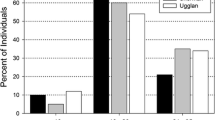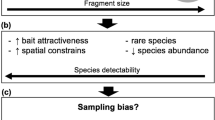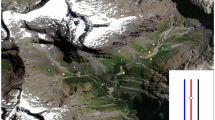Abstract
Pitfall trapping is believed to be the most efficient method for capturing shrews (Sorex spp.); however, Longworth live-traps have been used successfully in North America and Great Britain. Due to high metabolic rates, previous attempts to livetrap shrews have been faced with very high (exceeding 95 % in some circumstances) mortality rates. Here we report the results of two experiments attempting to integrate successful livetrapping of shrews into standard rodent trapping protocols. In Experiment 1 we compared efficiency of pitfall and Longworth live-traps operated with drift fences on 1-ha trapping grids for capturing vagrant shrews (Sorex vagrans) on agricultural set-asides in Delta, British Columbia, Canada. A total of 100 trap stations, on each of three trapping grids, were equipped with a 3-m-long drift fence and randomly assigned either one pitfall at the centre of each fence, or two Longworth traps, one at each end of the fence. In addition, we randomly selected 50 % of trap stations and provided 6 g of mealworms (Tenebrio molitor) larvae as bait. In response to high mortality rates, we varied the frequency of trap checks, with intervals of 12–14 h (long), 6–9 h (medium) and 3–4 h (short). Contrary to our predictions, Longworth traps captured significantly more shrews than pitfall traps. We observed the highest mean mortality rates in traps without mealworms, checked at long intervals. Shrews in mealworm-baited traps checked at short intervals experienced no mortality. Mortality rates in mealworm-baited traps checked at short and medium intervals were similar (t = −1.33, P = 0.20, Bonferroni-corrected alpha = 0.004). In Experiment 2, we attempted to determine the relative gains in efficiency when using drift fences in conjunction with Longworth and pitfall traps. However, due to small sample size, we were unable to detect significant differences. A trapping protocol using Longworth traps in conjunction with drift fences, provided with mealworms as food, and checked at a maximum interval of 8 h should be sufficient to effectively include shrews in rodent livetrapping studies.




Similar content being viewed by others
References
Anthony NM, Ribic CA, Bautz R, Garland TJ (2005) Comparative effectiveness of Longworth and Sherman live traps. Wildl Soc Bull 33:1018–1026
Beacham TD, Krebs CJ (1980) Pitfall versus live-trap enumeration of fluctuating populations of Microtus townsendii. J Mammal 61:486–499
Boonstra R, Bowman L (2003) Demography of short-tailed shrew populations living on polychlorinated biphenyl-contaminated sites. Environ Toxicol Chem 22:1394–1403
Boonstra R, Krebs CJ (1978) Pitfall trapping of Microtus townsendii. J Mammal 59:137–148
Boonstra R, Rodd HF (1984) Efficiency of pitfalls versus live traps in enumeration of populations of Microtus pennsylvanicus. Can J Zool 62:758–765
Brown LN (1967) Ecological distribution of six species of shrews and comparison of sampling methods in the central Rocky Mountains. J Mammal 48:617–623
Bury RB, Corn PS (1987) Evaluation of pitfall trapping in northwestern forests: trap arrays with drift fences. J Wildl Manage 51:112–119
Cawthorn JM (1994) A live-trapping study of two syntopic species of Sorex, S. cinereus, and S. fumeus, in southwestern Pennsylvania. In: Merritt JF, Kirkland GLJ, Rose RK (ed) Advances in the biology of shrews. Carnegie Museum of Natural History Special Publication no. 18, pp. 39–43
Chitty D, Kempson DA (1949) Prebaiting small mammals and a new design of live trap. Ecology 30:536–542
Churchfield S (1990) Natural history of shrews. Christopher Helm, London, England
Churchfield S, Barber J, Quinn C (2000) A new survey method for water shrews (Neomys fodiens) using baited tubes. Mammal Rev 30:249–254
Craig VJ (1995) Relationships between shrews (Sorex spp.) and downed wood in the Vancouver watersheds, B.C. thesis, University of British Columbia, Vancouver, BC
Crowcroft P (1951a) Keeping British shrews in captivity. J Mammal 32:354–355
Crowcroft P (1951b) Live-trapping British shrews. J Mammal 32:355–356
Dickman CR, Doncaster CP (1989) The ecology of small mammals in urban habitats. II. Demography and dispersal. J Animal Ecol 58:119–127
Gliwicz J, Taylor JRE (2002) Comparing life histories of shrews and rodents. Acta Theriol 47(suppl 1):185–208
Greenberg C, Miller S (2004) Soricid response to canopy gaps created by wind disturbance in the southern Appalachians. Southeast Nat 3:715–732
Handley COJ, Kalko EKV (1993) A short history of pitfall trapping in America, with a review of methods currently used for small mammals. Virginia J Sci 44:19–26
Hawes ML (1977) Home range, territoriality, and ecological separation in sympatric shrews, Sorex vagrans and Sorex obscurus. J Mammal 58:354–367
Hays WST (1998) A new method for live-trapping shrews. Acta Theriol 43:333–335
Innes DGL, Bendell JF (1988) Sampling of small mammals by different types of traps in northern Ontario, Canada. Acta Theriol 33:443–450
Kalko EKV, Handley COJ (1993) Comparative studies of small mammal populations with transects of snap traps and pitfall arrays in southwest Virginia. Virginia J Sci 44:3–18
Kirkland GLJ, Sheppard PK (1994) Proposed standard protocol for sampling small mammal communities. In: Merritt JF, Kirkland GLJ, Rose RK (ed) Advances in the biology of shrews. Carnegie Museum of Natural History Special Publication no. 18, 458 pp
Kutner MH, Nachtsheim CJ, Neter J, Li W (2005) Applied linear statistical models. McGraw-Hill/Irwin, New York, NY, USA
Lambin X, MacKinnon J (1997) The relative efficiency of two commercial live traps for small mammals. J Zool, London 242:400–404
Little J, Gurnell J (1989) Shrew captures and rodent field studies. J Zool, London 218:329–331
Long CA (1974) Microsorex hoyi and Microsorex thompsoni. Mammal Species 33:1–4
Malmquist M (1985) Character displacement and biogeography of the pygmy shrew in northern Europe. Ecology 66:372–377
Malmquist M (1986) Density compensation in allotropic populations of the pygmy shrew Sorex minutus on Gotland and the outer Hebrides: evidence for the effect of interspecific competition. Oecologia 68:344–346
McComb WC, Anthony RG, McGarigal K (1991) Differential vulnerability of small mammals and amphibians to two trap types and two baits in Pacific Northwest forests. Northwest Sci 65:109–115
Meidinger D, Pojar J (1991) Ecosystems of British Columbia. Special Report Series Number 6. Research Branch, Ministry of Forests, Victoria, British Columbia, Canada
Mengak MT, Guynn DCJ (1987) Pitfalls and snap traps for sampling small mammals and herpetofauna. Am Midl Nat 118:284–288
Pankakoski E (1979) The cone trap — a useful tool for index trapping of small mammals. Annal Zool Fenn 16:144–150
Pearson OP (1947) The rate of metabolism of some small mammals. Ecology 28:127–145
Pearson OP (1950) Keeping shrews in captivity. J Mammal 31:351–352
Prince LA (1941) Water traps capture the pygmy shrew (Microsorex hoyi) in abundance. Can Field-Nat 55:72
Pucek Z (1969) Trap response and estimation of numbers of shrews in removal catches. Acta Theriol 14:403–426
SAS Institute Inc (2003) SAS version 9.13. SAS, Carey, NC, USA
Shore RF, Myhill DG, Lhotsky R, MacKenzie S (1995) Capture success for pygmy and common shrews (Sorex minutus and S. araneus) in Longworth and pitfall traps on upland blanket bog. J Zool, London 237:657–662
Sullivan TP, Sullivan DS (2013) Influence of removal sampling of small mammals on abundance and diversity attributes: scientific implications. Human-Wildlife Interactions 7:85–98
Sullivan TP, Sullivan DS, Ransome DB, Lindgren PMF (2003) Impact of removal-trapping on abundance and diversity attributes in small-mammal communities. Wildl Soc Bull 31:464–474
Umetsu F, Naxara L, Pardini R (2006) Evaluating the efficiency of pitfall traps for sampling small mammals in the neotropics. J Mammal 87:757–765
Whittaker JC, Feldhamer GA (2000) Effectiveness of three types of live trap for Blarina (Insectivora: Soricidae) and description of a new trap design. Mammalia 64:118–124
Whittaker JC, Feldhamer GA (2005) Population dynamics and activity of southern short-tailed shrews (Blarina carolinensis) in southern Illinois. J Mammal 86:294–301
Williams DF, Braun SE (1983) Comparison of pitfall and conventional traps for sampling small mammal populations. J Wildl Manage 47:841–845
Yunger JA, Brewer R, Snook R (1992) A method for decreasing trap mortality of Sorex. Can Field-Nat 106:249–251
Zar JH (1999) Biostatistical analysis. Prentice-Hall, Englewood Cliffs, NY
Acknowledgments
We thank J.S. Richardson and K.M. Cheng for helpful comments on earlier versions of this manuscript. A. Kozak provided useful advice on statistical analysis. This work was made possible by a British Columbia Ministry of Environment grant to TPS.
Author information
Authors and Affiliations
Corresponding author
Additional information
Communicated by: Matthew E. Gompper
Rights and permissions
About this article
Cite this article
Stromgren, E.J., Sullivan, T.P. Influence of pitfall versus Longworth livetraps, bait addition, and drift fences on trap success and mortality of shrews. Acta Theriol 59, 203–210 (2014). https://doi.org/10.1007/s13364-013-0149-6
Received:
Accepted:
Published:
Issue Date:
DOI: https://doi.org/10.1007/s13364-013-0149-6




